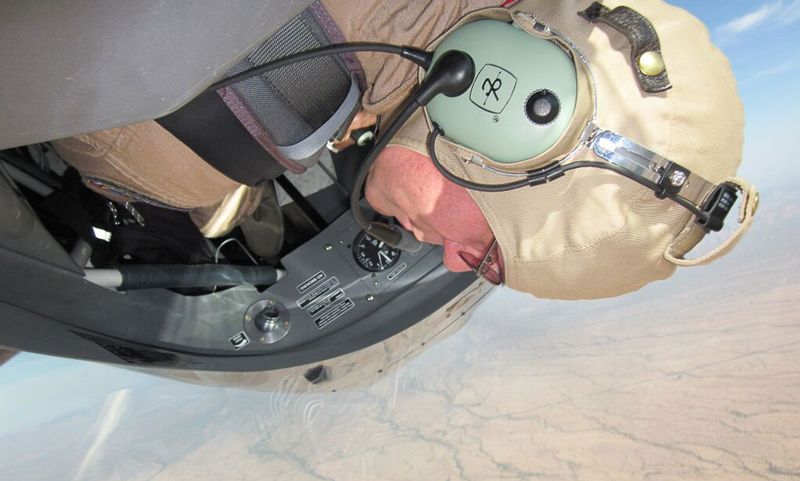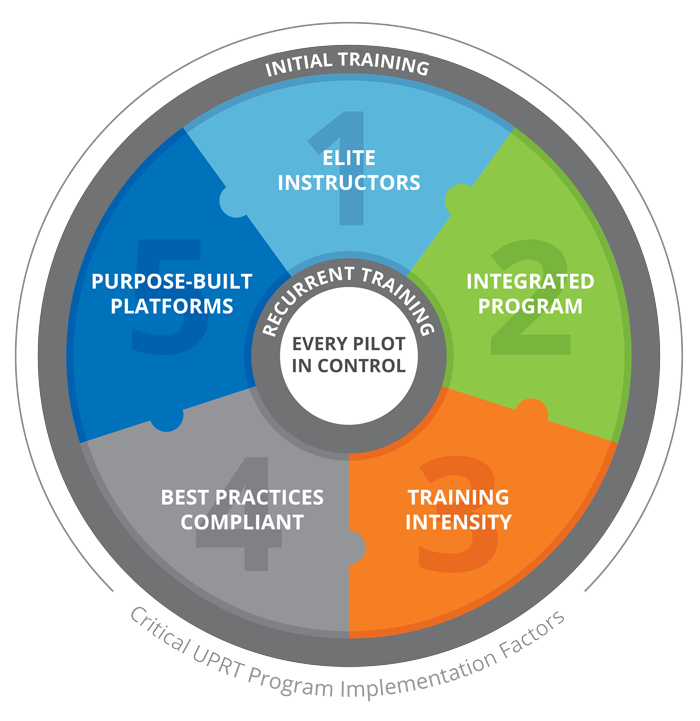Summary:
Several factors, or a combination of factors, can contribute to Loss of Control In-flight (LOC-I). While Upset Prevention and Recovery Training (UPRT) reduces the risk of LOC-I, the extent to which it is effective depends on adherence to specific best practices that address all the possible LOC-I contributing factors. The Every Pilot In Control Solution Standard™ outlines the most critical components of an effective and safely delivered UPRT program.

The Number 1 Fatal Threat
Loss of Control In-flight (LOC-I) claims approximately 50% of all fatalities in aviation; nearly equivalent to the sum of the fatalities associated with all the other causal factors combined. Why Does LOC-I persist as the number one fatal threat to aviation safety? There are several factors that perpetuate LOC-I as the leading cause of fatalities in aviation. Some of them impair a pilot’s ability to prevent an upset, others diminish their ability to recover from an upset event, and some can impede both prevention and recovery. A program billed as Upset Prevention and Recovery Training (UPRT) that does not properly address all of these contributing factors can be deficient at best, and at worst, will result in negative training that is dangerous for pilots and all who fly with them.
Understanding the Possible Causes of LOC-I
Undermining Upset Prevention
Airplane State Awareness (ASA) is a term that describes a pilot’s understanding of the aircraft’s attitude or energy state. A pilot’s ability to perceive and comprehend their current situation, and accurately visualize their future flight path has a name you’ve probably heard before: Situational Awareness. Not fully understanding the aircraft’s current situation certainly prevents a pilot from having an accurate picture of where it will be in the future. It is impossible to prevent bad situations that can’t be foreseen.
Another aspect of prevention is comprehensive Threat and Error Management (TEM). This is simply a safety management approach that actively identifies threats and errors and finds ways to mitigate them, which is the essence of prevention. For LOC-I, there are some threats that are not well recognized, since they cannot be replicated through flight simulation (both aerodynamic and human factors consequences). TEM is always looking for the lowest risk solution to prevent an escalating or developed upset event; however, this becomes difficult if pilots do not recognize unfamiliar flight situations that could precede LOC-I.
Undeveloped Upset Recovery Skills
Manual Handling and Manual Flight Operations Proficiency have been identified as areas of concern largely in association with degradation of skills due to automation. For LOC-I the situation is even worse, since it is not about losing skills that a pilot once had, but it is about skills that pilots never developed in the first place. Current required licensing skills only cover flight within + 30 degrees of pitch and 60 degrees of bank. That comprises only 11% of all possible flight attitudes, and no experience of how the aircraft will behave outside that realm.
Unfortunately, standard unusual attitude training done as a simulator training event is not sufficient. Even modified simulators with enhanced envelopes are still missing important aerodynamic modelling that represents how an aircraft would behave in certain aerodynamic situations. More importantly, the significant psychophysiologic and proprioceptive elements missing from even the best flight simulation eliminates factors crucial to success in an unexpected in-flight upset event. The majority of pilots have not developed aircraft handling skills appropriate or applicable in an upset. They misapply responses appropriate in the normal flight envelope that can be dangerous or catastrophic in the upset domain.
Missing Aspects of Both Upset Prevention and Recovery
Some factors can affect pilots prior to an upset, which can be prevented, or after it has escalated past the threshold of the normal envelope, requiring recovery. Problems with flight path automation or automation mismanagement is one of these. One of the first steps of manufacturer templates for the upset recovery process is to disconnect the automation. Over-reliance on automation due to lack of manual flight operations proficiency can degrade both upset prevention and recovery capabilities.
And last, Single-pilot Resource Management (SRM) or Crew Resource Management (CRM) is important on both sides of the upset boundary. Without a well-practiced, strategic response that addresses all recoverable upset events, pilots become “lost” in an upset without a firm path to follow in the face of cognitive impairment caused by surprise and startle effects.
Comprehensive vs Deficient Upset Training
The solution to the problem of LOC-I is comprehensive Upset Prevention and Recovery Training; however, regulatory guidelines are high level and lack the specifics required to ensure a UPRT program addresses all of the factors that contribute to LOC-I and that it addresses them as effectively as possible. For example, the ICAO Manual on Aeroplane Upset Prevention and Recovery Training stresses repeatedly that, “the most important factor affecting safety in the conduct of UPRT is a competent instructor qualified for the delivery of on-aeroplane UPRT who operates within a well-structured safety management system (SMS) environment.” However, the manual does not offer specific criteria to determine what exact qualifications a qualified UPRT instructor should have or what constitutes a ‘well-structured’ SMS. You can read more about additional types of possible upset training deficiencies here.
Because of this lack of detailed specifications regarding UPRT implementation, UPRT programs can vary greatly in all aspects of upset training delivery. In order to ensure that UPRT actually does what it is supposed to do — ingrain the skills necessary to recognize, prevent or recover if necessary from an unexpected airplane upset — UPRT programs must be quality assured and standardized according to well-established and tested industry best practices. In addition to effective skill development, quality assured and standardized UPRT programs also cultivate a safe training environment for instructors and students.

The Every Pilot in Control Solution Standard™
The the Every Pilot in Control Solution Standard (EPIC-S2™) identifies six critical UPRT program implementation factors that are needed to provide the foundation for any complete UPRT program delivering an effective solution to solve Loss of Control In-flight. The successful integration of these critical factors and compliance with specific criteria outlined in each one create a UPRT program that thoroughly, systematically and effectively addresses the problems identified above. The six categorical factors that make up the EPIC-S2 are: Elite Instructors, Integrated Program, Training Intensity, Best Practices Compliant, Purpose Built Platforms, and Initial and Recurrent Training.
The factors identified above probably sound familiar. In most cases, they mirror the same principles applied to many other aspects of quality pilot training. Unfortunately, many UPRT providers are missing one or more elements that are necessary to effectively and comprehensively address the factors that have created the problem with LOC-I that exists today.
A UPRT program that seamlessly and smoothly accomplishes the criteria outlined in the standard not only has the highest expectation of achieving lasting and effective upset prevention and recovery skill development, but also offers students an enjoyable, valuable and transformational training experience that will benefit them and all those who fly with them.




Comments: